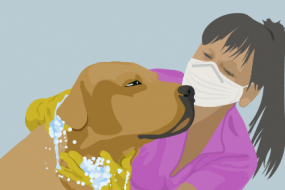Pet Safety in a Chemical Emergency
What should you do to keep your pet safe?
Chemical emergencies can happen because of accidents, such as a train derailment, or through a deliberate release, such as a terrorist attack.
You may need to take steps to protect yourself as well as your pets.
In a chemical emergency, follow the same steps as you would for yourself. You and your pet should get away from the area of chemical release. Once you are away, get any chemical off you and your pet as soon as you can (decontamination) to prevent health effects, and get help. Call the Poison Control Center at 800-222-1222, call 911, or go to the nearest hospital.
- Are you inside, and did you come in contact with (been exposed to) the chemical inside the building? Get outside into the fresh air and quickly move as far away from the area as possible. Take your pets with you.
- Are you outside a building and exposed to the chemical? Get as far away from the chemical release area and uphill, if possible, with your pet because some chemicals stay in low lying areas.
- Are you inside a building but have not been exposed to the chemical? Close all windows and doors and stay inside. Keep any pets inside with you. Stay put and seal off your space (shelter-in-place).

- Remove any chemical from yourself first by following these steps.
- Put on a mask and waterproof gloves.
- Put on a mask and waterproof gloves. If you don’t have a mask and gloves, use any available cloth to cover your face and plastic bags to cover your hands.
- Blot, do not rub, your pet’s face, body, and paws with a moist wipe, wet cloth, or damp paper towel.
- Wash your pet’s head, face, body, legs, and paws, working from head to tail with lukewarm water and mild skin soap, if available, for at least 2-3 minutes. Try not to get the water in the eyes, nose, and mouth. Do Not Scrub!
- Flush your pet’s eyes for 10-15 minutes with lukewarm water if your pet’s eyes are red or your pet is rubbing its eyes.
- Dry your pet. This helps remove any remaining chemical. Put any used things in a plastic bag, close it up, and put it in a second plastic bag. You may need to repeat the decontamination steps if you were exposed to more chemical while decontaminating your pet.
- Wear gloves and put the plastic bags in a closed container where they are unlikely to be opened by accident to prevent others from coming contact with the chemical. If you don’t have gloves, use plastic bags. Do Not Put the bags in the Regular Trash!
- Listen to the radio, television, or check your phone or mobile news app for updates from your police, fire, or local officials for instructions on what to do with your contaminated things.
- If you had to decontaminate, get help for yourself by calling the Poison Control Center at 800-222-1222 or calling 911, or going to the nearest hospital.
- If you had to decontaminate your pet, it may need to be checked by a veterinarian once the chemical emergency is over, and it safe to do so.
- If you were not exposed to the chemical, check the radio, television, your mobile news app computer, or text message alerts for more information on whether you need to stay put and seal off your space or evacuate.
This guide is primarily about dogs and cats. For tips on disaster planning for livestock, horses, birds, reptiles, or small animals, such as gerbils and hamsters, please visit Ready.gov or The Humane Society of the United States, or The American Society for the Prevention of Cruelty to Animals.